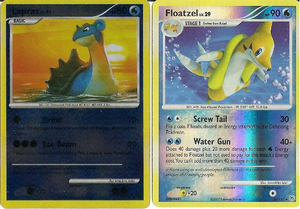Counterfeit card

A counterfeit card is a general term to denote any kind of custom, fictional or duplicate card based on cards from any particular trading card game, but are created by someone other than the original creators of that game, generally either by fans of the game or by some other company to sell to unsuspecting consumers. Since the release of the Pokémon Trading Card Game, fans and nefarious companies alike began to make fake Pokémon cards, and still continue to do so to this day, usually selling them in places like farmers' markets and dollar stores for very cheap prices.
In particular, counterfeit cards are cards created by companies other than Nintendo, Pokémon Inc., Pokémon USA Inc., Media Factory, Creatures or Wizards of the Coast, mostly by taking existing cards and making cheaper duplicates of them.
History of counterfeit Pokémon cards
Counterfeit cards are likely the first type of fake cards to exist, appearing shortly after the Pokémon TCG grew in popularity in Japan. Counterfeit Pokémon cards are generally duplicates of existing cards, often contain flaws or cheaper materials which make them inferior to legitimate Pokémon cards.
In the early days of the Pokémon Trading Card Game, when the cards were gaining popularity in Western countries, counterfeit Pokémon cards frequently appeared in hopes of fooling unsuspecting buyers unfamiliar with the Pokémon franchise, as well as buyers who were unconcerned with the legitimacy of the cards, as Pokémon merchandise was in high demand and stores would be often out-of-stock of legitimate cards. Early counterfeit cards, made by companies such as Q-boy, were often exact copies of legitimate Pokémon cards, but printed on cheaper card stock and usually missing copyright information. Due to the cheap reproduction technologies used, counterfeit cards usually have lower-quality artwork, with print colors varying from the originals. In the late 1990s, police forces seized thousands of fake Pokémon cards, including over 500,000 from a warehouse in Hackensack, NJ.[1]
Recent counterfeits are often more sophisticated than earlier attempts; however, modern counterfeits still have many flaws. Modern counterfeits are not usually direct copies of legitimate cards, and often contain critical spelling, grammatical, visual or factual errors. Common errors include the absence of the accented "é", wrong or mis-sized energy symbols, or mis-named Pokémon (such as "Farren" for Flareon or "Lation" for Latios). Often, counterfeit cards will be misprinted, making each card a humorous farce of its original (like a Psychic-type Rattata card with an attack that does 1000 damage, or a Magneton with 800 HP that should have 80). To further deceive potential buyers, modern counterfeits usually retain copyright information.
External links
- Anatomy of a Fake Pokémon Card Article at the PokéGym discussing how to spot a counterfeit Pokémon TCG card.
References
- ↑ Hintze, Hal. "Fake 'n' Bake." PoJo's Unofficial Pokémon News & Price Guide Monthly Dec. 1999: 120-21.

|
This article is part of Project TCG, a Bulbapedia project that aims to report on every aspect of the Pokémon Trading Card Game. |
